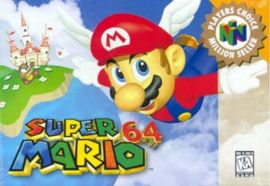Super Mario 64

| |
| Super Mario 64 | |
| Developer | Nintendo EAD |
| Publisher | Nintendo |
| System | Nintendo 64, Virtual Console (Wii, Wii U) |
| Release Date | Nintendo 64 JP June 23, 1996 US September 29, 1996 EU March 1, 1997 JP July, 18, 1997 (Rumble Pak Version) iQue CH November 2003 Wii Virtual Console JP December 2, 2006 US November 19, 2006 EU December 8, 2006 Wii U Virtual Console US April 1, 2015 EU April 2, 2015 JP April 8, 2015 |
| Gallery | GH Gallery |
| Rating | ESRB: K-A |
Super Mario 64 was a platforming adventure game released in 1996 as a launch title for the Nintendo 64. It is the first Mario game to feature true three-dimensional environments. It established a new version of the Super Mario game formula that would inspire countless other 3-D plarformers.
Story[edit]
One day, Mario receives a letter from Princess Peach asking him to come to her castle and have a piece of cake. When Mario arrives, he discovers that Bowser has taken over the castle imprisoned Peach as well as all of the castle's attendants within various walls and paintings of the castle. Mario must explore the castle and the various worlds that could be accessed through paintings in order to gather the Power Stars that are needed to challenge Bowser and save the princess.
Gameplay[edit]
The players controls Mario as he works his way through the various worlds that can be accessed from Princess Peach's Castle, which acts as the game's hub area. Mario is capable of a larger variety of movement than he had ever managed in his 2-D games. The power-ups of the previous games are replaced by three special caps. One cap grants flight, another makes Mario invisible, and a third gives Mario a metal suit. The caps appear much more sporadically than the power-ups from the previous games. This game also gives Mario a health meter.
The castle is divided into three different areas: the main floor, the basement, and the second floor. Each area is separated by a locked door. The key can be obtained by defeating Bowser. Each of these floors contain a variety of levels, which are usually accessible by jumping into a painting. Some, however, are hidden and can only be entered by a special method. Each painting is behind a door that requires a certain number of stars to open.
Legacy[edit]
The most lasting legacy of Super Mario 64 was its affect on 3-D platformers. Though it was not the first, it was more popular and well-received than others, leading to it inspiring the gameplay of various other 3-D platformers. It also laid the groundwork for future 3-D Mario adventures.
Elements of the game have also surfaced in other Mario and Nintendo properties. Prominently, Metal Mario has appeared as a separate character in several Mario games and as a boss in the original Super Smash Bros., with the Metal Box appearing as a transformation item in later Super Smash Bros. games.
Ports and Remakes[edit]
- In Japan, a special version of the game (known as the "Shindou Pak Taitou") was rereleased in mid-1997 that supported the Rumble Pak and made some other minor changes.
- In 2004, the game was remade as Super Mario 64 DS, which was as a launch title for Nintendo DS. The game included thirty new stars and the ability to play as Luigi, Wario, or Yoshi in addition to Mario, as well as other new features and heavily updated graphics.
- The original Nintendo 64 version was released for download through the the Wii's Virtual Console in late 2006 and on the Wii U's Virtual Console in 2015.
- In 2020, a remastered version of the game of the Shindou version of the game was included in the limited release of Super Mario 3D All-Stars for the Nintendo Switch, along with Super Mario Sunshine and Super Mario Galaxy.
- In October 2021, it was among the initial library of Nintendo 64 games that were made available to play with a subscription to the Expansion Pack of Nintendo Switch Online. The Shindou version of the game was available in the Japanese version of the app, while the original version of the game was the one available for the American and European apps.
Sequels[edit]
At one time, Nintendo was working on Super Mario 64 2 for the Nintendo 64DD, but it was canceled due to the failure of the peripheral. The game slowly turned into Super Mario Sunshine for the Gamecube. It was long believed that a game called Super Mario 128 was in development for the Gamecube as the "true" sequel to Super Mario 64, although it turned out to only be a technology demo, while features of it were later incorporated into Pikmin and Super Mario Galaxy.
See Also[edit]
| Titles in the Mario Series |
|---|
| Donkey Kong (GB) - Jr. - Mario Bros. - Mario Clash Super Mario Bros. (DX) (Lost Levels - 2 - 3) - Super Mario World - Yoshi's Island - Super Mario Land (2) Super Mario 64 (DS) - Sunshine - Galaxy (2) - 3D Land (World) - Odyssey Super Mario Advance (2 - 3 - 4) - New Super Mario Bros. (Wii - 2 - U) - Run - Wonder Mario vs. Donkey Kong - March of the Minis - Minis March Again! - Mini-Land Mayhem! - Minis on the Move - Tipping Stars Mini Mario & Friends: amiibo Challenge - Super Mario Maker (2) |